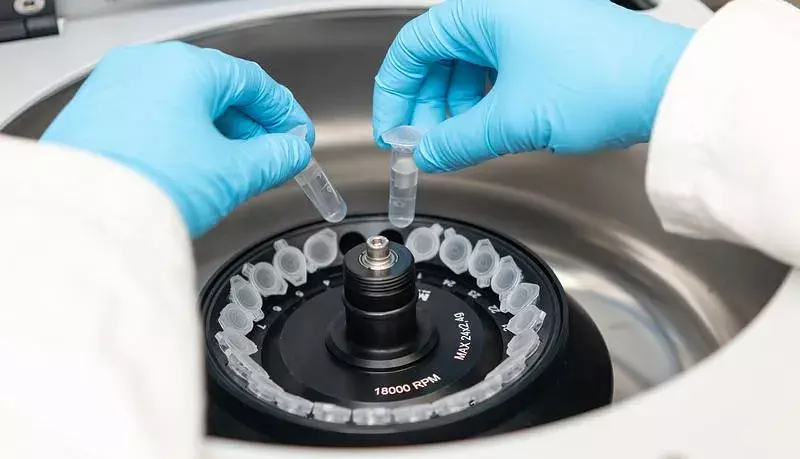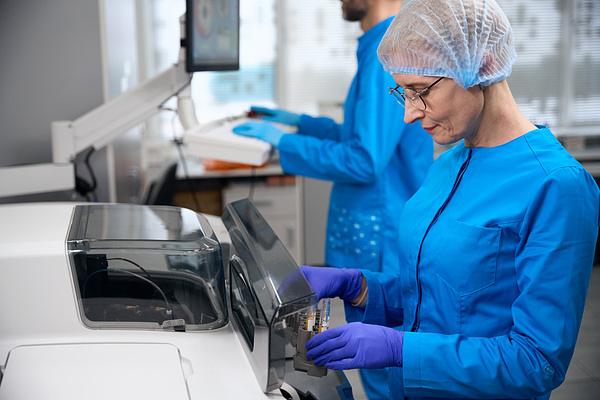 Tissue production is invaluable in the world of tissue research for medical and scientific purposes. Advanced devices are developed that smooth experimental tissues with exceptional accuracy and speed. From preliminary design to final inspection, dental processors handle every stage of the process, streamlining operations and speeding up results.
Tissue production is invaluable in the world of tissue research for medical and scientific purposes. Advanced devices are developed that smooth experimental tissues with exceptional accuracy and speed. From preliminary design to final inspection, dental processors handle every stage of the process, streamlining operations and speeding up results.
These raw materials are used in a variety of laboratories, from disease diagnosis to medical research. Its significance lies in the ability to standardize, reduce error, and increase efficiency with various neuronal techniques. Furthermore, the ability to simultaneously process large tissues enables faster diagnosis and enables researchers to conduct more experiments, providing deeper insights into human physiology.
Performance and accuracy are greatly improved by incorporating neural artifacts into laboratory workflows. These devices automate many steps in tissue preparation, freeing up laboratory technicians to focus on other important tasks. The consistent results generated by tissue engineering not only help healthcare professionals make reliable diagnoses, but also empower scientists to make great strides in understanding disease and developing treatments also. With LabLink’s expertise, integrating tissue processors into your lab is simple, ensures efficiency and opens new avenues in tissue analysis and diagnostics.
Understanding Tissue Processing
When it involves analyzing sicknesses and accomplishing biomedical research, understanding tissue processing is important. Tissue processing entails a chain of steps that put together tissue samples for examination below a microscope, permitting scientists and scientific professionals to benefit from insights into numerous components of fitness and disorder. In this blog subtopic, delivered to you by LabLink, we'll delve into the fundamentals of tissue processing, exploring the strategies and technologies worried, and highlighting its importance in histopathology and biomedical studies.
A. Definition and Purpose of Tissue Processing
Tissue processing involves a chain of sequential steps aimed toward getting ready organic tissue specimens for microscopic exams. The primary motive of tissue processing is to preserve tissue morphology, cell structures, and biomolecules even as eliminating water and other interfering substances. This method is crucial for histological analysis, in which accurate tissue morphology is critical for diagnosing illnesses and knowledge of pathological mechanisms.
B. Key Components of Tissue Processors
Tissue processors include numerous key components, along with reagent packing containers, tissue baskets, agitation mechanisms, and temperature manipulate structures. These components are painted together to facilitate tissue processing steps which include fixation, dehydration, clearing, infiltration, and embedding. Modern tissue processors regularly function consumer-friendly interfaces and programmable protocols, permitting laboratories to personalize processing parameters based on specific tissue kinds and packages.
 Types of Tissue Processors
Types of Tissue Processors
In histopathology and biomedical research, diverse sorts of tissue processors are to be had to satisfy the diverse wishes of laboratories. Each type gives unique capabilities and abilities, tailor-made to unique packages and possibilities. In this weblog subtopic, delivered to you via LabLink, we'll discover the specific varieties of tissue processors usually used in laboratories, starting from traditional guide processors to advanced automatic structures. By knowing the traits and functionalities of each kind, we will better recognize their role in streamlining tissue processing workflows and enhancing laboratory efficiency.
A. Manual Tissue Processors
Manual tissue processors require laboratory technicians to perform tissue processing steps manually, including moving specimens among reagent packing containers, changing reagents, and tracking processing times. While guide processors offer flexibility and cost-effectiveness, they're exertions-extensive and liable to variability because of human errors.
B. Automated Tissue Processors
Automated tissue processors, however, utilize superior robotics and computer-managed systems to automate tissue processing steps. These contraptions offer particular manipulation over processing parameters, steady outcomes, and better throughput compared to manual processors. Automated tissue processors are ideal for high-extent laboratories and applications requiring standardized processing protocols.
C. Comparison of Manual vs. Automated Systems
The preference between guide and automated tissue processors relies upon different factors, consisting of laboratory workload, finances, and processing necessities. While guide processors can be appropriate for small laboratories with constrained throughput, automatic processors provide superior performance, reproducibility, and workflow integration, making them best for huge-scale operations and high-complexity checking out environments.
The Tissue Processing Workflow
The tissue processing workflow encompasses a chain of sequential steps, every important for preparing tissue specimens for analysis or studies. In this weblog subtopic, added to you by way of LabLink, we'll delve into the tissue processing workflow, breaking down every step and highlighting its significance within the basic technique. From specimen collection to final embedding, we're going to explore the journey that tissue specimens undergo in the laboratory and look at the position of every step in making sure outstanding outcomes.
A. Specimen Preparation
The tissue processing workflow starts off with specimen collection and coaching, where tissue samples are acquired from patients or experimental topics and nicely classified for identification. Specimen preparation may also involve gross examination, trimming, and orientation to make sure most beneficial visualization of applicable anatomical systems.
B. Fixation
Fixation is the primary crucial step in tissue processing, where tissue specimens are handled with fixatives to keep cellular structures and biomolecules. Common fixatives include formalin, alcohol, and glutaraldehyde, each offering particular benefits relying on downstream applications.
C. Dehydration
Following fixation, tissue specimens undergo dehydration to dispose of water and put them together for next processing steps. Dehydration is usually finished through a chain of graded alcohol solutions, which regularly replace water molecules in the tissue while keeping tissue architecture.
D. Clearing
Clearing involves the elimination of alcohol from tissue specimens and the infiltration of a clearing agent to render tissues transparent. Common clearing dealers encompass xylene and toluene, which dissolve lipids and enhance tissue transparency, facilitating most reliable visualization all through embedding and sectioning.
E. Infiltration
Infiltration is the method by means of which tissue specimens are impregnated with a helping medium, consisting of paraffin wax or resin, to offer structural help for subsequent sectioning. Infiltration ensures that tissue specimens hold their shape and integrity at some point of embedding and sectioning approaches.
F. Embedding
Embedding is the final step in tissue processing, wherein tissue specimens are embedded in a strong medium, along with paraffin blocks or resin molds, for sectioning. Embedding helps the preparation of skinny tissue sections for microscopic exams and permits for the preservation of tissue morphology and architecture.
Applications of Tissue Processors
Tissue processors discover various packages, driving improvements in diagnostics, treatment, and scientific discovery. In this blog subtopic, we will discover the extensive-ranging programs of tissue processors across various fields. From helping in the analysis of illnesses to facilitating the development of novel treatment plans, tissue processors play a pivotal position in advancing healthcare and biomedical science.
A. Histopathology
Histopathology is the number one software of tissue processors, where processed tissue specimens are used for microscopic exams and analysis of illnesses. Tissue sections received from processed specimens are stained and analyzed by means of pathologists to identify abnormalities, signify illnesses, and manual affected person management.
B. Research Laboratories
Tissue processors are useful equipment in research laboratories, where they enable scientists to prepare tissue specimens for a huge range of experimental research. From investigating disease mechanisms to comparing therapeutic interventions, tissue processing plays an essential function in advancing our know-how of biological procedures and developing new treatments.
C. Pharmaceutical Industry
In the pharmaceutical enterprise, tissue processors are used for drug discovery, improvement, and safety evaluation. Tissue specimens processed the use of those units offer valuable insights into drug efficacy, toxicity, and pharmacokinetics, supporting pharmaceutical organizations to optimize drug applicants and ensure affected person protection.
Advantages and Challenges
In tissue processing, it is vital to recognize both the benefits and challenges associated with those state-of-the-art gadgets. In this blog subtopic, offered by using LabLink, we will delve into the advantages and ability hurdles of the usage of tissue processors in laboratory settings. From improved efficiency and consistency to technical complexities and maintenance requirements, tissue processors offer a variety of blessings and challenges that impact their usage and effectiveness.
A. Advantages of Using Tissue Processors
Tissue processors offer several benefits, consisting of standardized processing protocols, steady results, and increased laboratory performance. These instruments enable laboratories to handle huge volumes of specimens with minimum hands-on time, reducing processing errors and improving turnaround instances for diagnostic trying out and research research.
B. Challenges and Considerations
Despite their numerous advantages, tissue processors aren't without demanding situations. Laboratories have to keep in mind elements including tool renovation, reagent availability, and operator training while implementing tissue processing systems. Additionally, laboratories have to adhere to regulatory requirements and pleasant warranty standards to ensure the reliability and accuracy of processed tissue specimens.
